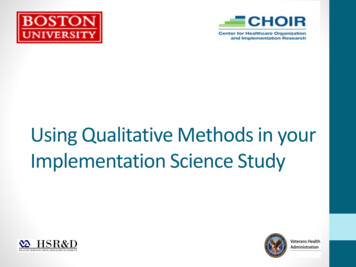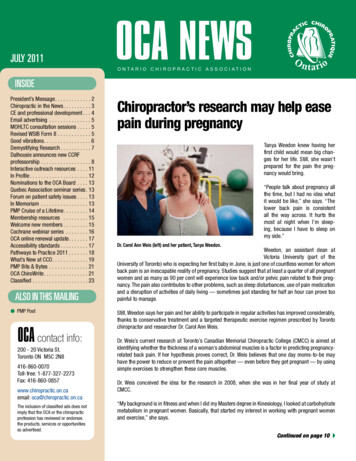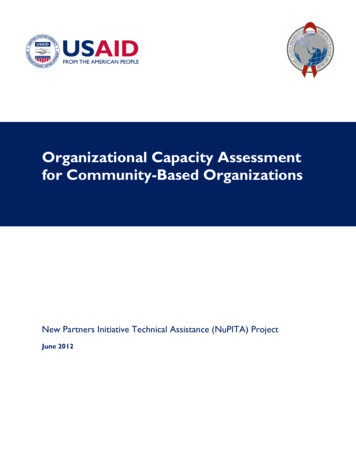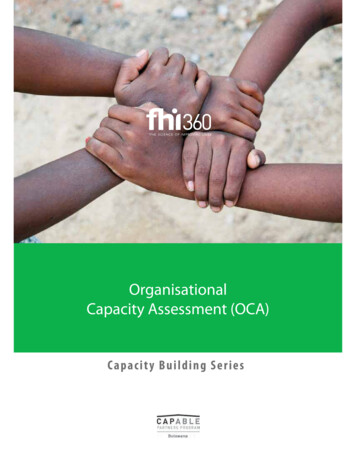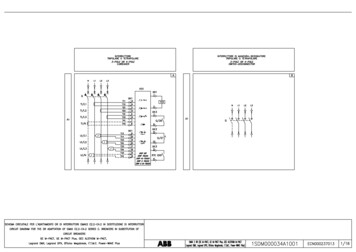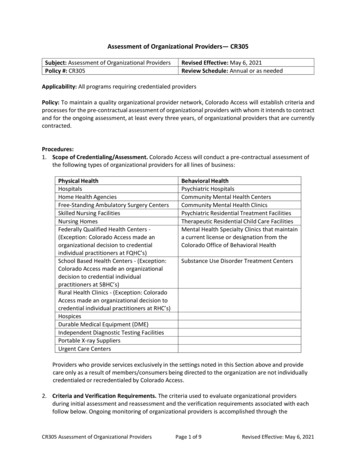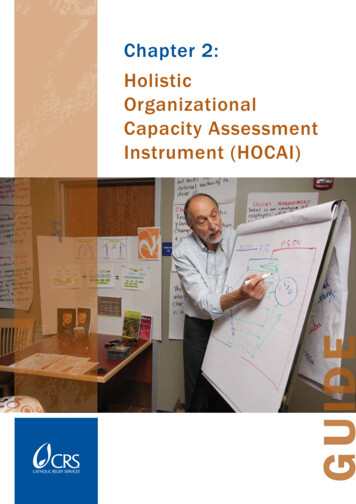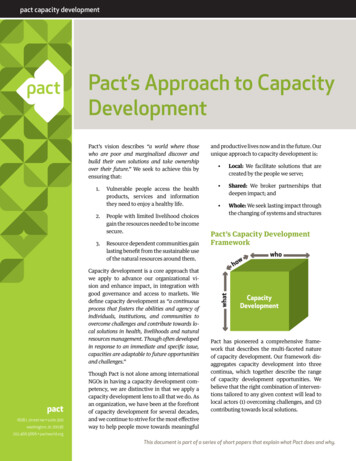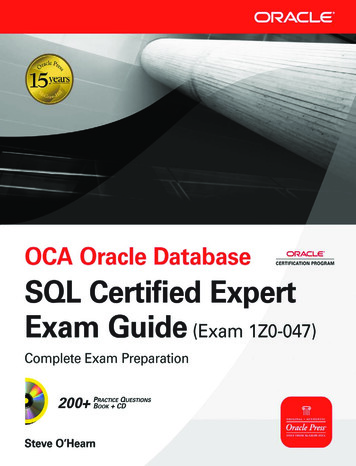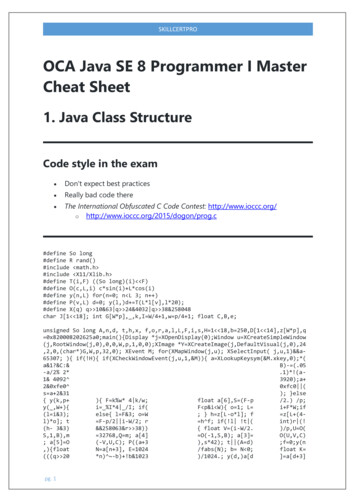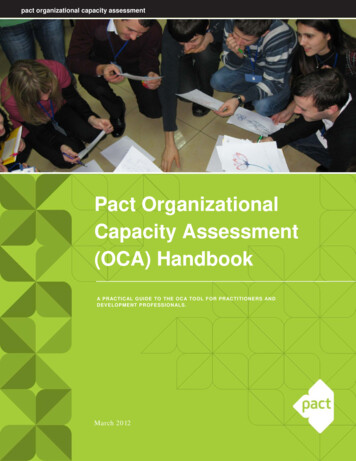
Transcription
pact organizational capacity assessmentPact OrganizationalCapacity Assessment(OCA) HandbookA P R ACTI C AL G UI DE TO THE OC A TO O L FO R PR ACT I TIO NE RS ANDDEVE LOPM ENT P ROFESS IO N AL S .March 2012
Table of ContentsTable of Contents . 2Purpose of this handbook . 3The Pact OCA - Description & Overview . 4Why engage partner organizations in participatory assessments? . 4The Pact OCA - What is it?. 5Where does it come from?. 6Why is it needed?. 6Who does it engage? . 7What makes it unique? . 7Key principles of the OCA . 8How does it work?. 9Step-by-step process . 10Classic OCA . 10Step 1: Partner Preparation. 10Step 2: Tool Design . 10Step 3: Guided Self-Assessment and Results Processing. 10Step 4: Results Debrief and Data-Guided Action Planning . 11Timeline & major milestones. 12Resources required . 12Staffing . 12Budget. 12Lessons learned . 14Results & efficacy data. 14Case story #1: Classic OCA Adoption in Ukraine . 14Case story #2: South Sudan’s CBO Excellence Initiative .16Success factors. 17Mistakes to avoid. 18Adaptations and impact area applications . 19Contextual considerations . 19Appendices and Resources . 20Appendix 1: Glossary . 21Appendix 2: Sample Classic OCA Scoring Sheet . 22Appendix 3: Extract from the CBO OCA Scoring Sheet .24Appendix 4: Sample Repeated OCA Results Comparison Charts.26Appendix 5: Contacts within Pact . 272
Purpose of this handbookThis handbook is intended to help development practitioners familiar with organizational assessments tounderstand the potential and use of Pact’s Organizational Capacity Assessment (OCA) tool. It is not meant as adetailed technical guide (for this, please see Appendix 8: Links to other materials). This document provides Pactpractitioner and manager with the information they need to understand how the Pact OCA works, and how best toincorporate it in their country strategy or program. While this document is primarily designed for internal Pactpurposes, it can be shared with donors and partners making funding or partnership decisions.Note: Thanks to the 16 country directors, chiefs-of-party, and OCA practitioners whose survey responses helped us develop this handbook. Aspecial thanks to Stephanie Marienau Turpin, Antonina Prudko, Svitlana Kuts, and Svitlana Tymchenko for allowing us to interview themfor the case stories, as well as Pact Vietnam and Pact South Sudan for sharing resources.Developed by the Productization Project Team: Jessica Benton Cooney, Rachel DuBois, Angela Gasparetti, Irene Gathinji, SarahOppenheim, Matt Reeves, Ryan Winger and Olga Yakimakho.Guidance provided by the Productization Oversight Group: Graham Wood, Suzanne Rexing, Katie Schwarm, and John Whalen.Please send any questions or comments to oyakimakho@pactworld.org.3
The Pact OCA - Description & OverviewWhy engage partner organizations in participatoryassessments?In the past decade, local ownership and organizational learning have become integral to many internationalprograms that engage in capacity development. The High- Level Forums on aid effectiveness in Rome, Paris,Accra, and Busan 1 increasingly underlined country ownership, development priorities set by aid recipients, andlocal capacity development as key areas of focus for implementers. These focal points have placed the future ofdevelopment in the hands of local organizations, many of whom still need greater capacity to assume thisleadership role.According to Pact’s capacity developmenttheory of change, stronger organizations havegreater impact on health, the environment andlivelihoods of their target communities. Thesuccess of these local organizations—which takecharge of improving their performance andincrease their ability to introduce meaningfulchange in their communities— depends on howwell they develop their capacity. To becomestrong and effective, organizations must assessand analyze the roots of their successes andchallenges.Families of organizational assessmentsExternally driven: engages an outside expert wholeads the process, analyzes results and makesrecommendations.Self-assessment: independent or facilitatedprocess of using a readily available tool for selfscoring and capacity strengthening plandevelopment according to industry standards.Customized self-assessment: independent orLocal actors are most empowered when theyfacilitatedprocess of developing individualhave the decisive voice in shaping their ownstandards of organizational performance andassessment; engage with teammates inbenchmarks for achieving the ideal state ofdiscussions about organizational capacity; anddevelopment.develop plans to strengthen their capacity,which they can carry out independently as theyswitch from one donor to another. Thecommitment and buy-in of local organizations istherefore critical. When a partner actively engages in an assessment using the Pact Organizational CapacityAssessment (OCA) tool described in detail in this handbook, the organization receives more relevant and deeperinsight into its capacity than an external expert review would provide. Coupled with the partner’s commitment toimprovement, follow-up plans are implemented effectively and sustainably.Self-assessments also enable partners to better measure their change in capacity and performance over time.Because during a Pact OCA, we are the facilitator and not the judge, the high level of trust developed with thepartner organization promotes dialogue and necessary organizational improvements that are not externallyimposed. Committed partners often track their own progress, and consistently provide updates.4th High Level Forum on Aid Effectiveness. Accessed at: iveness.html.14
Pact has been at the cutting edge of organization-centered learning for several decades. Our traditional OCA toolbelongs to the ‘customized self-assessment’ group (see Box 1 above). The Pact OCA allows partner organizations todrive their own assessments and capacity development processes, while at the simultaneously providing anecessary ‘reality check’ based on international best practices and organizational performance standards.The Pact OCA - What is it?The Pact OCA approach acknowledges that organizations are the owners of their development process. The OCAtool is participatory by nature and joins members from all levels of an organization, whenever possible, creating aspace for sharing, analyzing, and making judgments about organizational performance. The Pact OCA helpsorganizations identify their strengths and weaknesses on their own and identify unique organizational capacityareas (see Box 2), clarify their vision, plan forsuccess, and ultimately take greater ownershipover their future.Examples of Capacity Areas from VariousOCAs Facilitated by Pact:Often organizational capacity developmentfocuses on systems and structures, policies andLeadership and Management, Service Delivery,practices, and staff skill development. RecentHuman Resources Management, Finances and2advances of the OCA also integrate technicalAdministration, Core Values, Strategy, IT and(health, natural-resources management,Communications, Resource Mobilization,governance, etc.) assessment components intoStakeholders and Partnerships, Organizationalthe OCA to present a holistic picture of theStructure, Assets and Offices, Professional Skillsorganization and to lead the organization by itsmission and community impact rather thansystems and procedures.Since the late 1990s, Pact practitioners have used the OCA tool inmany different ways and in all parts of the world. The traditionalcustomized self-assessment OCA process has been tailored tomultiple contexts. The OCA tool can be implemented as the classiccustomized self-assessment or facilitator scored and thennegotiated with the partner organization; performed over anextended period of time or rapidly; tailored to an individualnon-governmental organization (NGO), community-basedorganization (CBO), governmental institution or business, ordesigned together with a cohort of organizations. Learning fromthese variations, which is summarized in this handbook, will guideyou as to how best to tailor the OCA to your context.The Pact OCA is NOT: A checklistJudgmentOrganizationalPerformance IndexCross-country comparisontoolGrant-making decisioninstrumentUSAID OCAThe OCA process builds capacity every step of the way. It generates several outputs, including an InstitutionalStrengthening Plan (ISP), also referred to as an Action Plan and Capacity Strengthening Plan, which describeshow Pact, other stakeholders and the organization itself will work together to support capacity development.Because various parts of the organization are engaged in the assessment, the organization’s commitment toimplementing these plans remains high even after the assessment ends. Data collected through the OCA process2The technical assessments may engage PCAT, ACAT, TOCAT and other tools (see Glossary in Appendix 1)5
can be used to track changes in the organization’s systems, policies and practices and contribute to trackingchange in organizational performance through the Pact Organizational Performance Index 3.Where does it come from?Designed to bring rigor and learning to theprocess of organizational capacity assessmentand strengthening, the Pact OCA is a product ofmultiple years of research and field practice.Pact developed our OCA methodology fromfield experience in South Africa and Ethiopia aswell as collaborative work with the EducationDevelopment Center (EDC) in the 1990s.Countries where Pact OCA has been used:South Africa, Ethiopia, Thailand, Lesotho,Vietnam, Ukraine, Kenya, Tanzania, Myanmar,South Sudan, Nigeria, Malawi, Namibia,Botswana, Swaziland, Nigeria, Madagascar,DRC, Afghanistan, Cyprus, United States,Ecuador, Bolivia, Rwanda,, Sierra LeoneLaos, Cambodia, Mongolia, Sudan, ZambiaPact and EDC, with funding from USAID’sOffice of Private and Voluntary Cooperation,developed the pre-cursor to OCA: theDiscussion-Oriented Organizational SelfAssessment (DOSA). The breakthrough of thisapproach was its ability to help NGOs identifyperceived organizational strengths and weaknesses, explore differences of opinion regarding these perceptions,and create consensus around future organizational capacity development activities. The methodology also enabledNGOs to assess change over time, thereby tracking the degree to which such capacity-building activitiescontributed to significant changes and increased capacity to deliver better results; and to benchmark theirindividual organizational results against a peer group or cohort oforganizations.The classic, customized self-assessment OCA methodology we use todaybuilds on the foundation of the DOSA, but tailors the design of theassessment tool to participating organizations to ensure the tool’srelevance. It also includes action planning to guide implementation ofpriority capacity development efforts.The Pact OCA tool has beenused by more than 150facilitators for almost twodecades.A second root of Pact’s contemporary OCA methodology is found in thework of William Booth, Radya Ebrahim and Robert Morin on the Pact OCA tool in 1998. The OCA tool is acustomizable organizational assessment methodology that operates through the negotiation of scores betweenorganizational participants. The original OCA tool formed the basis for many Pact OCA tools developed andapplied across Eastern and Southern Africa. The tool spawned the idea that assessments could be scored by thefacilitator and then negotiated with the partner organization, on way of conducting the OCA. The full OCA toolmethodology is described in the book Participatory Monitoring, Evaluation and Reporting: An OrganizationalDevelopment Perspective for South African NGOs.Why is it needed?Facilitated, participatory organizational capacity assessments are the most effective way of looking atorganizational strengths, weaknesses, successes, and areas for improvement. If performed well, they provide theThe Pact Organizational Performance Index is a tool that tracks change in organizational performance over timeand is used in data collection for Pact’s Global Capacity Development Indicator (http://tinyurl.com/PactOPI).36
deepest and most truthful insights into organizational performance weighted against multiple opinions.Structured conversation about organizational capacities conveys the connections between different organizationalfunctions, and identifies internal best practices for replication across teams and departments. The Pact OCA tool: Brings the organization together, develops trust, and opens communication. Empowers and engages non-management staff in organizational development processes, typicallyproclaimed to be ‘managers’ issues’. Serves as a capacity development exercise. Generates organizational commitment to ISP implementation. Builds trust between the organization and the external capacity developer. Serves as the starting point for Pact’s follow-up capacity strengthening engagement, with the partner’sentire staff understanding the rationale behind it. Examines the organization holistically. Enables iterative, learning-based development that helps organizations adapt to the changingenvironment.There is also an imperative from donors to conduct the OCA.USAID FORWARD Procurement Reform and the Local CapacityDevelopment Initiative borrowed from Pact’s OCA and itsprecursor DOSA to build USAID’s Organizational Capacity Tool.Immersing partners into Pact’s OCA approach will prepare themfor the potential USAID assessment, and consequently, directfunding from this donor.Who does it engage?Potential participantsIndividual members oforganization: leaders, managers,officers, volunteers, financial, HR,administrative and other staffmembers; board membersThe Pact OCA tool can be used with various types of actors.According to Pact practitioners who have used the tool, the mostcommon groups engaged are civil-society organizations (CSOs),CBOs, networks, cohorts, and local governments. Less than 10percent of OCAs involve businesses.Organizations: all types of civilsociety organizations, communitybased organizations, governmentinstitutions, businesses, peacecommittees, and women’s groupsMuch like other Pact approaches (e.g., Local GovernanceBarometer or Organizational Network Analysis tool (ONA)), oneof the OCA tool goals is to bring different actors into the roomtogether for reflective dialogue. It is important not to limit OCAparticipants to senior management. A broad, cross-functional andcross-hierarchical array of organizational members, or for smallerorganizations, the full staff team should be engaged.Groups (cohorts) oforganizations: formal, informal, andsectoral networksWhat makes it unique?Pact OCA’s facilitative nature, on the other hand, empowers capacity development rather than determinesdecisions on funding disbursements 4. The unique nature of the Pact OCA tool rests in how we engage eachorganization in the assessment exercise. Organizations are engaged in the process through:4For grant pre-award assessment purposes, Pact usually uses its Management Control Assessment Tool (MCAT).7
Dialogue to reach consensus on successes and issues fromacross the organization, rather than unilateral judgmentby an external expert;Flexibility in applying the tool and defining capacity areasto ensure that it fits into the organizational context andenvironment;Measurement of the organizational consensus in additionto capacity scoring, which triangulates the results andconveys hidden disagreements without finger pointing;andCohort application within one community/country toengage in sharing and learning; in a cohort OCA process,several peer organizations collaborate to develop the selfassessment tool and engage in a joint discussion of thecomparative anonymous results post-assessment.Pact Ethiopia conducted a customizedOCA with a government partner, whichdeveloped what seemed like too manyindicators (statements of excellence)to assess the organization. Uponbeing challenged to reduce thatnumber, a representative said thatalthough they are many, “internallythey really touch us.”Key principles of the OCAPact developed its OCA methodology around the following four core principles that prove true in all adaptations: Participation and user ownership are the key to OCA success. The more engaged and empowered thewhole organization is throughout the entire process, the more learning is spread. Commitment to followthrough capacity development rests within all teams of the organization. Customization ensures capacity areas measured are those most relevant to the environment andexperience of each country’s civil society. Communication between group members, the organization, and facilitators, as well as sharing of resultsacross organizations helps to reveal relevant issues and build consensus. Continuous learning that stems from revisiting assessment results and tailoring the ISPs provides asignificant catalyst for change and adaptation.Based on these principles and Pact’s experience, we’ve found that the OCA works best when: Partners trust that the assessment will not affect their grants with Pact and engage in the exercise for theirown benefit and not as a funding requirement. The partner’s leadership sees value in the process and is ready for an honest conversation with their staff. The partner organization is prepared for the work involved and commits to participate in the plannedactivities. The assessment is carried out on the organization’s timeline and reflects the partners’ needs. Pact staff understands the main principles of OCA and are ready to tailor the process to the needs of theorganization without jeopardizing the quality of the results. Pact’s facilitation team is cross-functional, i.e. represents various areas of knowledge such as technical,financial, and capacity development. The process engages members from all parts of an organization.8
How does it work?Every Pact OCA includes preparing the partnerorganization for the upcoming activity by clarifyinggoals, processes, and expectations of both sides. Thefacilitator and the organization determine who shouldparticipate in the assessment to represent the diverseopinions from all departments of larger organizations, orthe full staff team for smaller entities.A typical OCA then engages the partner organization ineither tool design or revision of a ready-made tool withindicators, or statements of excellence 5 by capacity area(See Appendices 4 and 5 for sample tools). Once the toolis ready, the group engages in a facilitated discussionand assessment exercise, which results in a set of scoresprocessed and summarized by the facilitator. Adistinctive feature of the OCA is that it calculates notFigure 1: A Typical OCA Results Chart (the abbreviationsonly the capacity level, but also consensus among thecorrespond to the organization’s capacity areas: LM –participants (Figure 1), which allows disagreements to beleadership and management, MR – mission andsolved efficiently. The qualitative and quantitativerepresentation, etc.)insights that emerge from this process open newchannels of communication and information-sharingand serve as a catalyst for team-building and organization-wide learning. Once the results are ready, the groupconvenes again for a debriefing and action-planning workshop. The OCA process may be repeated on an annualor bi-annual basis depending on programmatic needs and resources.There are several variations of the OCA, including: Classic OCA, CBO OCA and the Rapid OCA. The followingalgorithm is helpful in deciding what type of OCA will be useful to your project:Statements of excellence are aspirational indicators that describe the ideal quality of a capacity area; forexample, “leaders actively promote staff participation in planning and decision-making” under capacity area‘Leadership.’59
Step-by-step processAs mentioned in the OCA description above, the tool can be customized in multiple ways for different types ofpartner organizations. The Classic OCA described in detail below is the recommended option for long-term, keypartners of Pact. With short-term partners or when budget and time constraints do not allow for the Classic OCA,the Pact team may use the Rapid OCA. In some cases—depending on the civil- society context or donorrequirements—the Pact practitioner will use the Facilitator Scored and Negotiated OCA. The differences withCohort and CBO OCAs are also described in the boxes below.Classic 6 OCAStep 1: Partner Preparation Pact identifies which key partner organizations will undergo the OCA self-assessment based on the impactarea strategy, project priorities, and the budget.Pact convenes meetings with the leaders of the organization to introduce the methodology and receive theirbuy-in.The facilitators and the organization’s leaders jointly identify the goals and process and agree on theexpectations of the process.The partner organization commits the time necessary to complete the Classic OCA by scheduling theappropriate number of sessions.The plan for using OCA results is drafted to ensure that there is sufficient support to engage in capacitydevelopment after the assessment.Step 2: Tool Design Participants gather for a workshop to develop their own capacity areas, statements of excellence (indicators)for each capacity area, and to discuss the scoring system 7 suitable for their context (see Appendix 4 for samplestatements of excellence and scoring sheet).Facilitators finalize the tool after the workshop, including development of benchmarks for the calibratedscoring, and prepare for the self-assessment activity.Step 3: Guided Self-Assessment and Results Processing Pact convenes a two- or three-day workshop during which selected participants from the organization (or thewhole organization for smaller entities) engage in a facilitated discussion and score each capacity area.After the workshop, the facilitator processes all scores by using the results processing Excel spreadsheet withOCA formulas that calculate capacity and consensus.A report with all results is prepared, which might include comparison charts with previous OCAs.The Classic OCA used to be referred to as the “full OCA”.A regular scoring system uses Likert scale of strongly agree / agree / neither / disagree / strongly disagree. Acalibrated scoring system uses narrative benchmarks for each level of a statement of excellence rather thansubjective numbered scoring. This adds rigor and validity to the discussion that precedes scoring.6710
Step 4: Results Debrief and Data-Guided Action Planning The same group convenes for a two- or three-day workshop.Data-guided action planning begins with the organization’s interpretation of the data, which ensures thecontextualization and validation of results (one day).Based on the conclusions agreed upon by the participants, they develop an action plan (one day).Post-workshop, participants refine the action plan into a set of concrete actions with goals, timelines, andresponsibilities that constitute an ISP.Step 5: Institutional Strengthening and Continuous Learning The partner organization implements activities outlined in the ISP with Pact’s support.The organization engages in periodic learning and feedback activities (at staff meetings or dedicatedevents).Re-assessment using the OCA process can take place once every year or two years.Adjustments made when adapting the OCA are highlighted in the boxes below.Rapid OCAFacilitator Scored, Negotiated OCAThis type of OCA can be used in time- and resourceconstrained situations, or with short-term partners. Itis important to remember that the results will likelyhave a less transformative impact on the organization. Pact prepares the tool based on existing predesigned tools and tailors it to the needs of theorganization. Instead of longer workshops, Pact convenes oneday scoring and results debrief/planning meetingswhich cover each capacity area to a lesser extentthan the Classic OCA. The organization takes responsibility fordeveloping its action plan independently after theworkshop.In some circumstances, such as donor requirements orspecific project design, assessments must incorporateexternal perspective while scoring organizations. ThePact OCA allows scoring to be performed by thefacilitator and negotiated with the organization toensure they agree with the scores. The process follows the Classic OCA, howeverinstead of the participants scoring themselves,facilitators perform the initial scoring. The scores are then presented to the organization,and when there is a disagreement with the score,the organization provides evidence to support theirargument. Consequently, the follow-up discussions focus oncapacity area only, and not consensus.Cohort OCACBO OCAWorking with a group of organizations allows learningto be shared from individual assessments and strategiesto be set for developing standards of excellence. The OCA tool is designed in a participatory mannerby the members of the cohort of organizations. The self-assessments are carried out by eachorganization separately from the group, following aClassic or Rapid OCA. After individual assessments, the cohort meets toreview assessment results (without revealingindividual scores), discuss trends, set groupperformance standards, and engage in grouplearning activities.CBOs working in only one community often havenascent, informal structures and a volunteer staff bas
drive their own assessments and capacity development processes, while at the simultaneously providing a necessary 'reality check' based on international best practices and organizational performance standards. The Pact OCA - What is it? The Pact OCA approach acknowledges that organizations are the owners of their development process. The OCA
